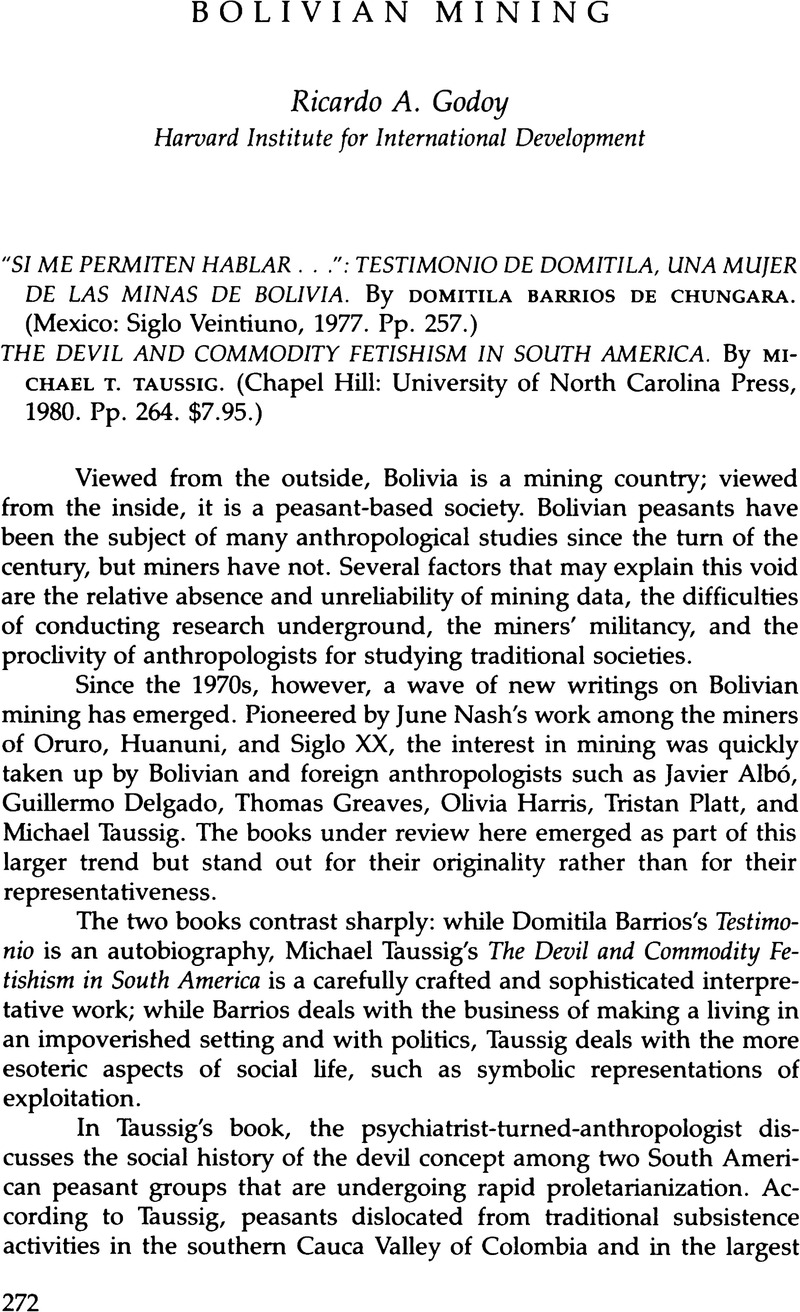Article contents
Bolivian Mining
Review products
Published online by Cambridge University Press: 12 October 2022
Abstract

- Type
- Review Essays
- Information
- Copyright
- Copyright © 1985 by the University of Texas Press
References
Notes
1. Peter J. Bakewell, “Registered Silver Production in the Potosí District, 1550–1735,” Jahrbuch fur Geschichte von Stoat, Wirtschaft und Gesellschaft Lateinamerikas 12 (1975):60; also his “Technological Change in Potosí: The Silver Boom of the 1570s,” Jahrbuch für Geschichte von Staat, Wirtschaft und Gesellschaft Lateinamerikas 14 (1977):65; Luis Capoche, Relación general de la Villa Imperial de Potosí (Madrid: Atlas, 1959), p. 108; Antonio Mitre, “The Economic and Social Structure of Silver Mining in Nineteenth-Century Bolivia,” Ph.D. diss., Columbia University; Enrique Tandeter, “La producción como actividad popular: ‘ladrones de minas’ en Potosí,” Nova Americana 4 (1981):47; also Tandeter's “Forced and Free Labour in Late Colonial Potosí,” Past and Present 93 (1981):130.
2. See Bakewell, “Registered Silver Production,” pp. 57–103, and “Technological Change in Potosí,” pp. 57–77. Also, Mitre's dissertation, cited in note 1; Joseph Barnadas, “Una polémica colonial: Potosí, 1579–1584,” Jahrbuch für Geschichte von Staat, Wirtschaft und Gesellschaft Lateinamerikas 10 (1973):16-70; and Enrique Tandeter, “La Rente comme rapport de production et comme rapport de distribution: la cas de l'industrie miniere de Potosi, 1750–1810,” Ph.D. diss., University of Paris, 1980.
3. See María Rostworowski de Diez Canseco, Recursos naturales renovables y pesca, siglos xvi y xvii (Lima: Instituto de Estudios Peruanos, 1981), p. 68; R. M. M. Crawford, D. Wishart, and R. M. Campbell, “A Numerical Analysis of High Altitude Scrub Vegetation in Relation to Soil Erosion in the Eastern Cordillera,” Journal of Ecology 58 (1970):176; H. Ellenberg, “Man's Influence on Tropical Mountain Ecosystems in South America,” Journal of Ecology 67 (1979):401-16; O. F. Cook, “Agriculture and Native Vegetation in Peru,” Journal of the Washington Academy of Sciences 6 (1916):289-90; and David Browman, “Pastoral Nomadism in the Andes,” Current Anthropology 15 (1974):193. See also Ricardo Godoy, “Ecological Degradation and Agricultural Intensification in the Andes,” Human Ecology (forthcoming).
- 1
- Cited by




